 이 누리집은 대한민국 공식 전자정부 누리집입니다.
이 누리집은 대한민국 공식 전자정부 누리집입니다.
|
|||||||||||||||||||||||||||||||||||||||||||||||||
-
What is National Institute of Korean Language's Korean-English Learners' Dictionary?
-
National Institute of Korean Language's Korean-English Learners' Dictionary is a bilingualised dictionary for Korean learners, consisting of translations from the Basic Korean Dictionary into English.
With an increase in the number of Korean learners and a long history of Korean education, the demand for a dictionary that takes account of the diversity of linguistic cultures of learners and the ever-changing educational environment has gradually grown. In order to meet these demands and circumstances, National Institute of Korean Language launched the Basic Korean Dictionary in 11 languages in 2012. Experts from many different fields such as Korean education experts, translators, native speakers who are proficient in Korean, and system developers have participated in the project over an extended period of time, so as to develop a user-friendly dictionary of optimum quality.
The key tool that is indispensable when learning a new language is, of course, a dictionary. We hope this dictionary will be of help to all Korean learners and teachers.
Basic Korean Dictionary: A web-dictionary for learning Korean that has been compiled in Korean for Korean learners and teachers
11 languages: Russian, Mongolian, Vietnamese, Spanish, Arabic, English, Indonesian, Japanese, Chinese, Thai, French
-
-
What are the features of National Institute of Korean Language's Korean-English Learners' Dictionary?
-
National Institute of Korean Language's Korean-English Learners' Dictionary is the first online bilingualised dictionary for learning Korean. The Dictionary offers an abundance of information needed to learn Korean, such as words, useful information, and cultural information, in various forms such as text and multimedia, to make learning Korean a fun and interesting experience.
1. A dictionary that provides an ample number of headwords, examples, and diverse learning information necessary for learning Korean
We selected 50,000 vocabulary words needed to learn Korean.
We classified the necessary vocabulary words into elementary, intermediate, and advanced levels of Korean and marked them with stars. (★★★ Elementary vocabulary, ★★ Intermediate vocabulary, ★ Advanced vocabulary).
We defined the selected vocabulary words so that they are easily comprehensible, and added multimedia materials to assist further understanding.
We provided examples that are used in daily life in diverse forms of phrase, sentence types, and conversation.
The Dictionary divides the vocabulary by theme and situation that is often encountered when learning or teaching Korean.
2. A bilingual dictionary that takes account of the learner’s language and culture
The headwords and definitions of the Basic Korean Dictionary were translated, taking the learner’s language and culture into consideration. You can search and look up individual words, or idioms·proverbs, in Korean or English.
Every language was translated by the best translators in the country and edited by native speakers in order to achieve a higher quality of translation.
3. A dictionary that is user-friendly and user-centered, allowing users to particiate in improving the dictionary
We applied a web-based environment that users could use easily.
We implemented a connection among all information so that users can access data easily.
We made all information easily accessible from portable devices, Internet websites, etc.
4. A dictionary with constant updates and development
Users can make suggestions regarding the dictionary’s content.
Based on the copyright policy, the content can be used freely due to knowledge contributions.
-
-
How can I look up words easily?
-
In National Institute of Korean Language's Korean-English Learners' Dictionary, you can look up the word of your choice in both Korean and English.
Try finding the word of your choice in Korean or English as follows:
① Type the word you want to find either in Korean or English and click the Search icon. Following your click, a list of search results that match your search word will appear on the screen.
<Searching with the word “나무”>

<Searching with the word “tree”>

② If the autocomplete search function is on, the word you are searching for will be automatically completed and suggested when you enter a search word.
(You can turn off the function by clicking the tab again.)
<Searching “나무”>
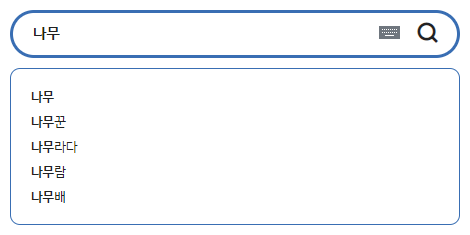
<Searching “tree”>
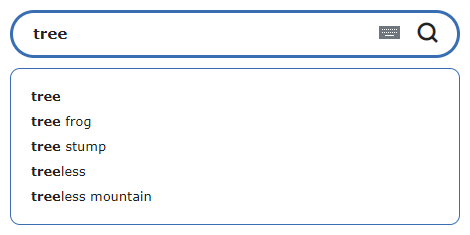
E.g. If you enter “나무” in Korean, words that include “나무” such as “나무배,” “나무뿌리,” etc., will be automatically found. If you enter “tree” in English, words that include “tree” will be automatically found.
-
-
How can I look up idioms·proverbs that include “ㅇㅇ”?
-
In this dictionary, you can search not only vocabulary but also find out how a certain vocabulary is used in idioms·proverbs, definitions, and usage examples in both Korean and English. If you want to look up idioms·proverbs that include a certain word, you can enter the search word and click on the Idioms·Proverbs tab in the search results.
<When you search a usage example that includes “눈” in the definition tab>
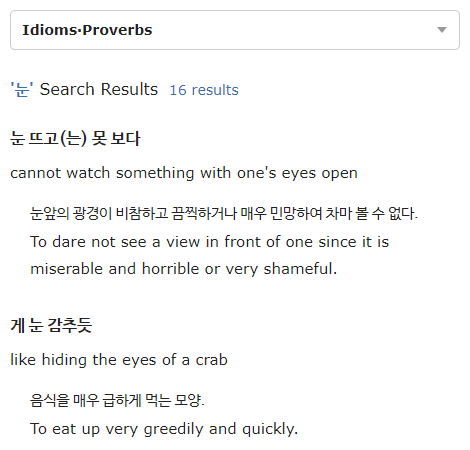
<When you search a usage example that includes “eye” in the definition tab>
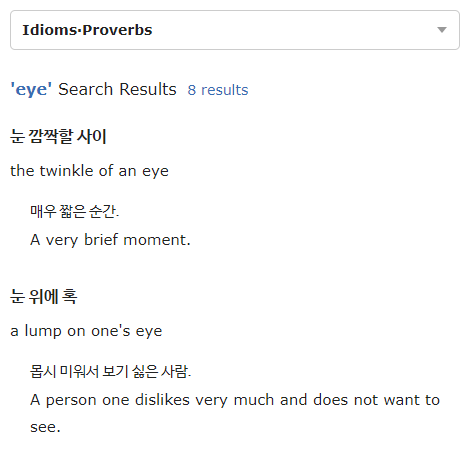
-
-
I want to look up an National Institute of the Korean Language Korean-English Dictionary definition that includes “ㅇㅇ”.
-
In this dictionary, you can search not only vocabulary but also find out how a certain vocabulary is used in idioms·proverbs, definitions, and usage examples in both Korean and English. If you want to look up some usage examples of a certain vocabulary in the definition, you can enter the search and click on the Definition tab in the search results.
<When you search a usage example that includes “눈” in the definition tab>
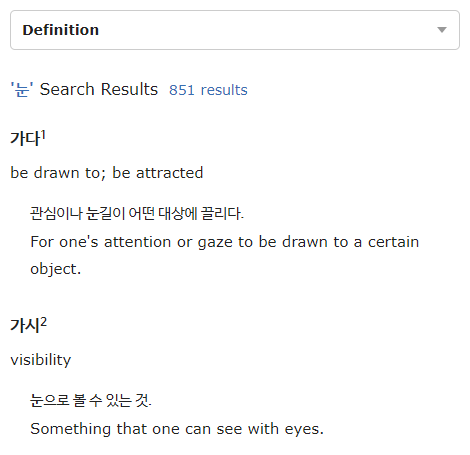
<When you search a usage example that includes “eye” in the definition tab>
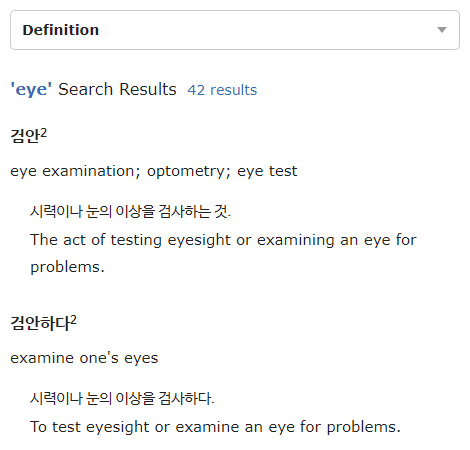
-
-
How do I look up a usage example that includes “ㅇㅇ”?
-
In this dictionary, you can search not only vocabulary but also find out how a certain vocabulary is used in idioms·proverbs, definitions, and usage examples in both Korean and English. If you want to look up how a certain vocabulary is used in a usage example, you can enter the search word and click on the Usage Example tab in the search results.
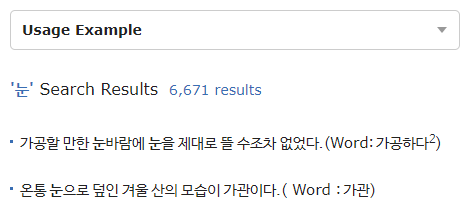
-
-
I would like to find a word in Korean, but I don’t remember exactly what it was. Is there any way to find it?
-
When looking up a Korean word, you can use the wildcard symbols (*, ?) with your search words even if you don’t remember exactly what word you were looking up. Please insert the symbol “*” or “?” before and after the your search word.

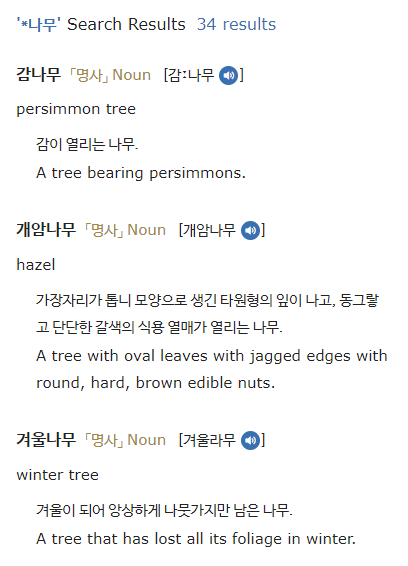
The wildcard symbol “*” means that regardless of the number of words, you can have all the search results including the word you search.
If you put “*” before the word you’re searching for, you will get search results that end with your search term. On the other hand, if you put “*” after the word you’re searching for, you will get search results that start with your search term. For instance, if look up “*나무”, you will get the words ending with ‘나무’ such as ‘가시나무’, ‘감나무’, and ‘개암나무’.
Usage example: ‘*나무’, ‘나무*’, ‘나무*나무’
Unusable example: ‘*나*무’, ‘**나무’


The wildcard symbol “?” means that you will get search results matched with the number of characters you specify.
If you write one “?” after your search word, you will get three-character words.
For example, if you write “나무?”, you will get three-character words starting with “나무” such as ‘나무꾼’, ‘나무람’, and so forth.
You can use several ‘?’ in a row. If you put two “?”s after “나무”, you will get four-character words starting with your search term.Usage example: ‘??나무’, ‘나무??’, ‘나무?나무’
Unusable example: ‘?나무?’
-
-
Can I make a suggestion regarding dictionary content?
-
By clicking the Send an Opinion tab, you can make a suggestion regarding dictionary content.
After clicking the Send an Opinion tab located below the View Dictionary page, you can fill in the related information and send it.① Click the Send an Opinion tab on the View Dictionary page

② Send an Opinion page
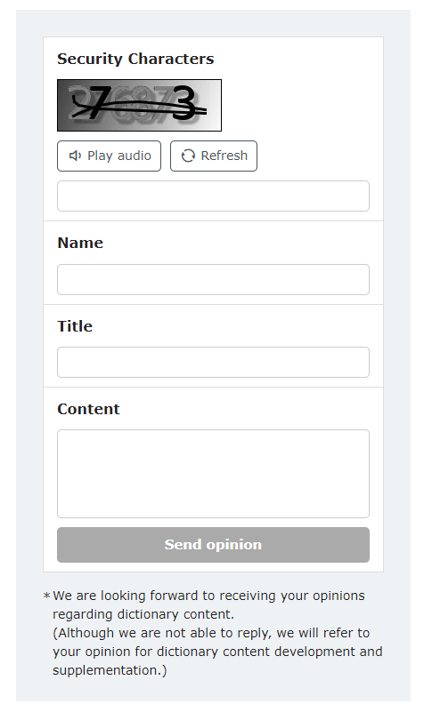
We are looking forward to receiving your opinions regarding dictionary content.
(Although we are not able to reply, we will refer to your opinion for dictionary content development and supplementation.)
-

